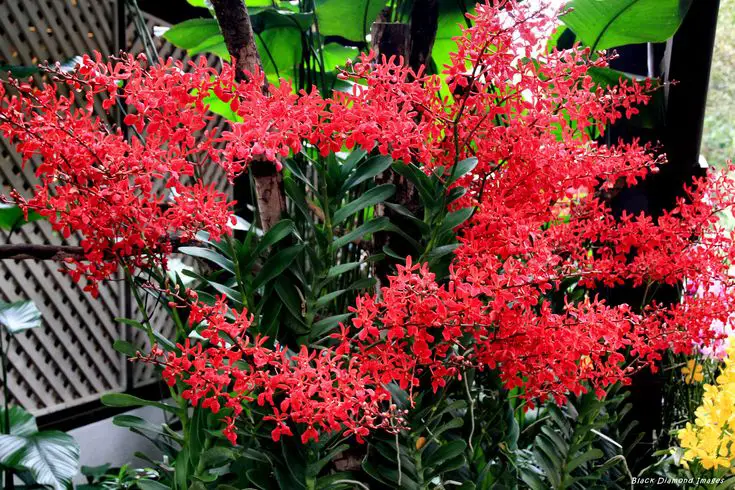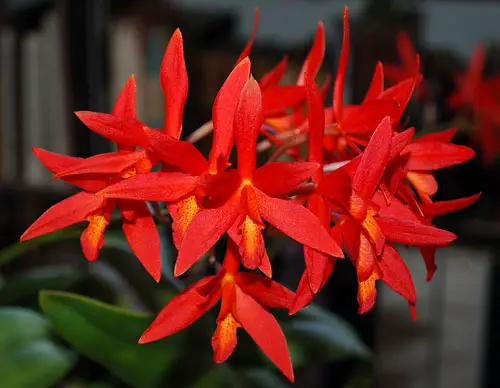LATIN NAME: RENANTHERA COCCINEA (EPIDENDRUM RENANTHERA)
Main genus : Renanthera
| Homeland | China Laos Myanmar Vietnam Thailand |
|---|---|
| The soil | No soil or substrate for epiphytic orchids (large fraction). |
| The size | from 50 to 150 cm |
| Flowering time | January to December |
| Possible colors | Red |
| Illumination | Many // West, South orientation, may require several hours of direct sunlight |
| Watering | A lot // Needs a constantly moist soil (watering more than 3 times a week) |
| Difficulty leaving | A lot // Requiring care (cold wintering, supplementary lighting, shelter (in the garden), etc.) |
| Air humidity | Much // High humidity (60% or more: tropics all year round; typical summer humidity in the middle lane) |
| Fertilization frequency | Little // Enough nutrition. substances from our own soil or rare fertilizer |
| Content temperature | warm content (+22 – + 27 ° C) |

Renanthera Kalsom (red dragon) Orchid Specifications and Structure
Plant size and type:
Renanthera bright red large monopodial epiphyte with climbing stem over 100 cm long.
Pseudobulbs:
Shoots are straight, powerful, climbing, not branching, up to 1.5 cm thick and more than 100 cm long, covered with tubular leaf sheaths.
Leaves:
Leaves 7–8 cm long and 1.5–3.3 cm wide, numerous, two-row, 3.8 cm apart. Leaf-blades are belt-like to oval, with rounded, slightly bifurcated tops.
Peduncle:
In the upper part of the shoot grows 4-5 peduncles up to 100 cm long. Flowers in the inflorescence, which is a branched raceme, are loosely located.
Flowers:
The inflorescence is multi-flowered. The flowers of Renanthera are bright red, dark red with yellowish spots on the upper sepals, petals, and lip. The upper sepal is straight, oblong, with a blunt tip and slightly wavy edges. The lateral sepals are narrow at the base, then widen, forming an almost oval surface with a blunt apex and wavy edges. The oblong petals are horizontal or directed upward at a slight angle. Their edges are straight, at the top they can slightly bend up. The three-lobed lip with a spur is much smaller than the rest of the flower. The lateral parts of the lip are triangular, the middle part is ovoid, its apex is bent back and almost touches the spur.
Flowering period: in nature, it blooms from April to June, in culture, flowering is longer.
Must check
Where renanthera kalsom ‘red dragon’ found in nature?
Myanmar, China, Laos, Thailand, and Vietnam. In China, this species is found in Guangdong province and Hainan Island, as well as in Taiwan. On the island of Hainan, the orchid grows on tree branches, on rocks in woodlands, or on the edges of a forest along ravines at an altitude of about 1400 m above sea level. In Thailand, it is found in several places in the east and southeast of the country, as well as in the vicinity of Ranong, preferring wet, sun-exposed areas. In Vietnam, Renanthera bright red grows in the north, along the border with China at an altitude of 650-1200 m.
The climate in natural habitats:
- Fixed temperature range from –5 ° C to + 35 ° C.
- The average humidity is 80–85% most of the year.
- Precipitation from 13 mm. in December and January up to 284 mm. in August.
- Average temperatures (day / night) in summer are + 28 ° C / + 9–10 ° C, and in winter + 15–17 ° C / + 6–8 ° C.
How take Care of Renanthera Orchid?

Temperature:
In summer, the average daytime temperature is + 28 ° C, the average nighttime temperature is + 19–20 ° C, and the daily temperature drop is 8–9 ° C.
Lighting:
40,000-50,000 suites. The lighting should be as bright as the plant can handle without burning the leaves, but it grows best if protected from direct sunlight at midday. Some orchid growers, however, believe that the bright red Renanthera needs full sun for the best flowering. Constant strong ventilation is required.
Watering:
From late spring to autumn, abundant rainfall falls in the bright red Renanthera habitats, but it is dry during 3-4 winter months. In culture, during the period of active growth of the orchid, its substrate should be constantly moist, but not soggy, and the space around the roots should be well ventilated. At the end of autumn, watering should be gradually reduced.
Fertilizer:
It is recommended to feed the orchid with a 1/4 to 1/2 dose of orchid fertilizer during the growing season. From spring to mid-summer, fertilization with a high nitrogen content is preferred, followed by fertilization with a high phosphorus content until the end of autumn.
Potting Mix:
Because of the length of the plant and its climbing stem, it is more convenient for Renanthera to grow bright red in flat containers with good drainage, to which long pegs, moss-covered branches, or tree fern perches are attached. The plant requires high humidity, during hot and dry weather it needs to be watered several times a day. The container can be a flat pot or basket with a very loose, water and breathable substrate that dries quickly after watering. Usually, medium or large bark is used, or chopped tree fern fibers, or pieces of cork with the addition of varying amounts of perlite and/or chopped sphagnum, so that the substrate is looser and more moisture-consuming. The addition of charcoal also increases the permeability of the substrate and protects it from acidification. If the substrate starts to decompose, the plant must be transplanted immediately. It is best to transplant when new roots begin to grow, in which case Renantera’s bright red adapts faster.
Air humidity:
Most of the year, humidity is 80–85%, but in winter and late spring, it drops by about one month to almost 75%.
Here is our best all about Miltonia Orchid care, varieties, etc.
Rest period:
In winter, the average daytime temperature is + 15–17 ° C, the average nighttime temperature is + 6–8 ° C, and the daily temperature drop is 7–9 ° C. In the bright red Renanthera habitats to the south, winter temperatures are significantly higher than those shown in the climate tables. This means that the plant can adapt to temperatures up to 7 ° C above those indicated.
In winter, there is little rainfall in nature, but plants receive additional moisture in the form of abundant dew. In culture, the plant’s substrate may dry out a little between waterings, but should not stay dry for too long. Usually, regular morning sprays between infrequent light waterings are sufficient. In some regions, the dry season is not so harsh, plants native to these areas can adapt to other irrigation schemes if they are less dry and cooler in winter. Topdressing should be reduced or stopped altogether until late spring when new growths appear and abundant watering resumes.
